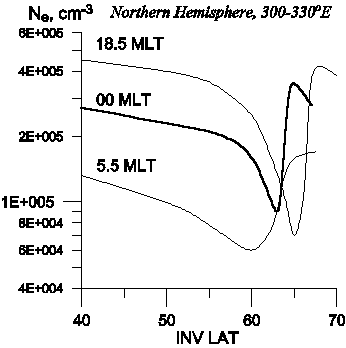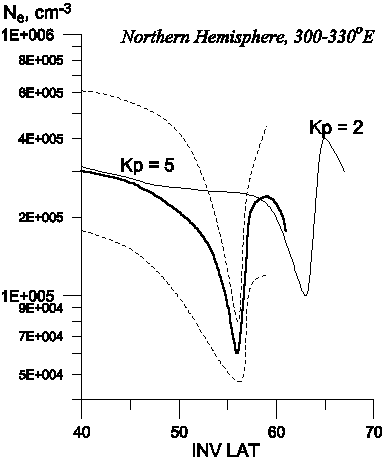
|

Pushkov Institute of Terrestrial Magnetism, Ionosphere and Radio Wave Propagation Russian Academy of Sciences ( founded in 1939 ) |

|
| Language [RU/EN] |
| Home | UP | Research | Projects | Services | Info | News | Events | Personal | Archive |
|
The dependence of the main ionospheric trough shape on longitude, altitude, season, local time, and solar and magnetic activityA. T. KarpachevInstitute of Terrestrial Magnetism, Ionosphere, and Radiowave Propagation, Russian Academy of Sciences, Troitsk, Moscow region, 142190 Russia e-mail: karp@izmiran.ru Pages: 1 | 2 | 3 | 4 | 5 Contradicting results have been also obtained concerning the local time of observation of the deepest trough. For example, the trough was deepest at a height of about 550 km near midnight according to Ariel 3 satellite data [Tulunay and Sayers, 1971] and at a height of 300 km in the evening in the Southern Hemisphere and in the morning in the Northern Hemisphere according to AE-C satellite data [Brinton et al., 1978]. However, Ahmed et al. [1979] noted in their review that the authors of the later paper compared different longitudes in different hemispheres, which is an incorrect approach. Analyzing the chain of ground-based sounding stations along the Yakutsk meridian, Ben'kova and Zikrach [1983] obtained that MIT is widest and deepest in the evening and in the morning at low solar activity and either at midnight or near 0300 LT at low at high solar activity. However, analyzing the topside sounding data obtained onboard the Intercosmos-19 satellite (high solar activity) for Arkhangelsk longitudes, Ben'kova et al. [1993] showed that the trough has a steep equatorial wall in the evening sector and, therefore, is deeper and wider here than in other periods. Besprozvannaya [1973] drew exactly the same conclusion from ground-based data. According to data of ionospheric tomography [Kersley et al., 1997], the steepest wall is also observed at 1800 LT. Mutually contradicting conclusions were also made concerning the MIT width. For example, the trough proved to be narrowest in the morning according to ground-based data [Lockwood, 1980] and in the evening according to Ariel 3 data for heights of 480-600 km [Tulunay and Sayers, 1971]. Apparently, it seems impossible to combine these data into a unified consistent pattern. Therefore, we now pose a narrower problem: to reveal the variations in the MIT depth and width with local time, using Cosmos-900 data obtained for high solar activity, and to obtain a quantitative measure of these variations. Since the MIT shape strongly depends on magnetic activity, quiet conditions (1 <= Kp <= 3) were selected to study the MIT shape diurnal variations; i.e., very quiet and slightly disturbed conditions were not considered. Data on Ne obtained at a height of about 500 km in December 1978 - January 1979 were used in an analysis. To eliminate of strong variations with longitude, we considered data only for the narrow longitudinal sector (300-330o) in the Northern Hemisphere. The Ne latitudinal profiles in the 1800-1900, 2300-0100, and 0500-0600 LT intervals were obtained by averaging several tens of satellite orbits. Results of averaging are shown in Fig. 5. In the evening the electron concentration drops steeply towards high latitudes, and the inflection point in the latitudinal profile of Ne is determined with some uncertainty. Therefore, in the evening the trough depth and width can be 3-4o and about 5o, respectively. The MIT width is 3o at the 2Nmin level. The MIT depth decreases to 2 at midnight. The width at the 2Nmin level, which coincides in this case with the inflection point, increases up to ~5o. In the morning the trough becomes much shallower (~1.5) and wider (~11o). Thus, independently of the method of estimation, the trough is most developed in the night sector than in other hours and is slightly more pronounced at midnight than in the morning. 
The electron concentration at a trough minimum varies slightly during the night, in the evening being even lower than at midnight. These characteristics fit well a stagnation theory. According to this theory, the trough is formed in the night sector as a result of the ionization decay in the stagnation region. Together with the rotating Earth, the trough moves to later local times and simultaneously shifts equatorward. In the course of time, the concentration decreases more intensely on the equatorial wall than on the polar one. In the absence of solar ionization, Ne is maintained by precipitation of particles, whose intensity decreases toward morning hours, on the polar wall and by the weak flux from the plasmasphere and the effect of the neutral wind on the equatorial wall. At a trough minimum the evening concentration is at a level typical of morning hours. The equatorward component of the meridional wind reaches its maximal amplitude near midnight; therefore, the electron concentration at a trough minimum slightly increases at that time. The concentration in the trough region, including its bottom, reaches minimal values in the morning. Immediately after the discovery of MIT, Sharp [1966] found out that it shifts equatorward and changes its shape with increasing magnetic activity. He assumed that the auroral ionization zone shifts equatorward during a storm and fills the trough, which becomes narrower. Such a viewpoint was also supported by Galperin et al. [1990]. However, we consider that this scheme is too simplified. For example, using data on the total electron content (TEC), Liszka [1967] observed MIT intensification with increasing magnetic activity and related it to the action of the electric field. Using ground-based sounding data, Besprozvannaya [1975] also observed deepening of the trough. During the disturbance the electron concentration increased at midlatitudes, whereas traces of the old trough were accompanied by the new trough at high latitudes. Tulunay and Sayers [1971] also observed trough deepening with increasing magnetic activity. Ben'kova et al. [1993] obtained again different results from different data. According to Intercosmos-19 data, MIT was much deeper during a disturbance than in the quiet period. According to data obtained at the Yakutsk chain of ground-based stations at high solar activity (1968-1969), the considerably increased polar wall of MIT moves towards the equatorial wall. As a result, a MIT minimum is actually filled up and MIT becomes shallower during a disturbance [Ben'kova and Zikrach, 1983]. In this case the electron concentration on the equatorial wall slightly increases in pre-midnight hours and decreases after midnight; however, this insignificantly changes the above conclusion. Recently, Shubin and Annakuliev [1997] obtained almost the same result based on data of ground-based sounding in the Northern Hemisphere. According to data of ESRO-4 [Kohnlein and Raitt, 1977], the trough was also filled up during a disturbance and became shallower. Thus, the pattern of MIT shape variations is again absolutely inconsistent. We will try to understand the causes of this inconsistency. To analyze the trough shape variations with increasing magnetic activity, we used data of the Cosmos-900 satellite obtained at Kp ~ 5 during several storms in December 1978 - January 1979. Quiet periods with Kp ~ 2 between these storms were selected for comparison. All data are related to the near-midnight conditions at high solar activity (F10.7 ~ 200). The narrow longitude sector (300-330o) in the Northern Hemisphere was considered again. Figure 6 shows the averaged latitudinal variations in Ne (solid curves) for the conditions considered and the extreme cases of the narrowest and widest troughs (dashed curves) for Kp = 5. Under quiet conditions the trough width and depth are 3.5-5 and ~2.3, respectively, depending on the way of determination. If the Kp index increases from 2 to 5, the trough average width decreases to ~2.5-4o and the depth increases to ~3. In contrast to the scheme suggested by Shubin and Annakuliev [1997], this narrowing is caused by deepening of a trough minimum. At that time the concentration at the MIT polar wall even decreased rather than increased. The width of the narrowest trough observed during the considered disturbances was only 2o (at a level of 2Nmin). In this case the electron concentration at both MIT walls was considerably increased relative to the mean (quiet) level. This is apparently related to the development of the Ne positive disturbance. In any case, the most probable cause of the formation of a very deep trough during a relatively short period after the beginning of the disturbance is the effect of the increased electric field of magnetospheric convection. The lower dashed curve shows the case of the widest trough. In this case the plasma density was sharply reduced, especially at the polar wall. Apparently, this decrease was caused by the development of a deep negative disturbance of Ne. The trough width (~6-10o) was considerably larger than in the quiet periods due to the development of a large peak of Te at the equatorial wall of MIT. It is widely known that Ne and Te variations anticorrelate in a first approximation. 
Thus, if the Kp index increases from 2 to 5, the trough becomes on average wider and deeper because the plasma density at a trough minimum also decreases. This is evidently related to the effect of the disturbed electric field. However, if a Te peak develops at the equatorial wall bottom rather than at a MIT minimum, the trough can be wider than in quiet periods. Moreover, the MIT shape depends on how the positive and negative phases of a storm develop in time and space. Thus, changes in the trough shape with increasing magnetic activity depend on many factors, which can be superimposed on one another in a different order depending on how this particular disturbance develops. Therefore, the above-mentioned factors will lead to different results in each particular case. Thus, it is clear why different authors obtained different results. Consequently, the problem of trough shape variation with increasing magnetic activity cannot be solved by a simple averaging of different values of the Kp index, and the storm prehistory should be taken into account. Next page » |
 |
|
(C) 2007, IZMIRAN
|

